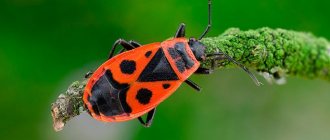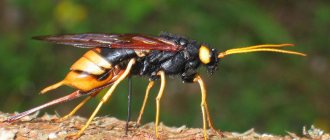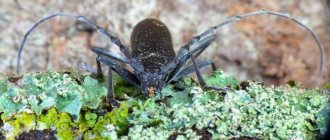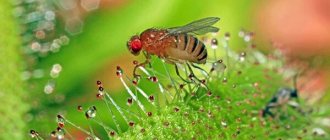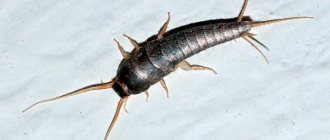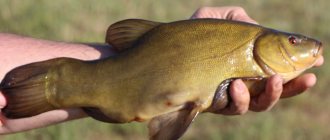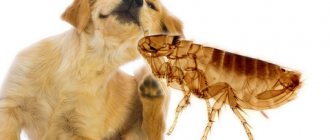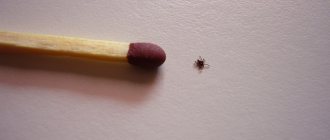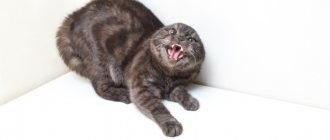- Wild animals
- >>
- Insects
The stink bug , which produces an unpleasant odor, is familiar to almost everyone since childhood. This is a common insect found in many temperate countries. Because of its pungent, unpleasant smell, it was rightly called “stinker.” Most often this is what the garden bug is called. However, other types of bedbugs also secrete a special secretion in case of danger, which is why they are also often called stinkbugs.
Stinky bug in the apartment - what to do?
In Russia, the stink bug insect is quite widespread. These insects love moisture, so most often they can be found near bodies of water. During the breeding season, insects move to drier habitats and often end up in a house or apartment. If you find bedbugs in a living room, it will be enough to throw the insects out the window, since they do not pose any threat to health.
Where does the stink bug come from and does it bite?
The scientific name of the stink bug is wood stink bug. It is known as an insect that feeds on the sap of garden and wild plants, which ultimately leads to their death. The beetle has a special specific smell, by which a person can determine that it is a stink bug, even without seeing it. Insects have different colors, they change with the season and weather conditions. If in summer the shield bug is green, then closer to autumn it turns brown, as if adapting to the surrounding environment. The different colors of the stink bug are shown in the photo:
I get stink bugs into my house most often by accident, flying through a window or vent. In the apartment they become disoriented and attempt to fly. They can get into the living space intuitively, feeling the warmth and finding themselves in the apartment during a sharp deterioration in weather conditions. Natural disasters and fires can also be the cause. The insect instinctively seeks better living conditions, but does not pose any danger to human health.
How long does a beetle live and who eats them?
The stink bug can live longer in an apartment than in the wild. Low temperatures do not kill the beetle, but shorten its lifespan from 1.5 years to 1 year or less. The female stink bug lays eggs daily, about 1-12 eggs. Thanks to the secretion produced, it attaches them to the surface of walls, furniture, ceilings, etc.
The places where bedbugs are located can be determined by the smell of this secretion. Depending on the ambient temperature and humidity in the room, the duration of egg development depends. Favorable conditions contribute to rapid development, about 30-40 days; under worse conditions, the indicator doubles: 80-100 days. The stink bug is food for larger insects (spiders, red ants), as well as for rodents.
What do stink bugs eat and how do they reproduce?
The stink bug has a special sucking apparatus with spines, which is designed to extract juice from plants by piercing their surface for food. In winter, the beetle falls into suspended animation, and with the onset of spring and the appearance of the first plants, it awakens and goes in search of food. Most often, the stink bug is found on gooseberry and raspberry bushes; among the trees it is alder and larch.
After settling on any plant where there are enough reserves for living, the stink bug lays eggs on the leaves of a bush or tree. After two weeks, the eggs turn into larvae, which also feed on plants. The larvae are bright green in color, they can be seen in the photo:
Social structure and reproduction
Photo: Insect stink bug
In the social structure of bedbugs, the strongest always takes precedence. Competition is especially evident during the breeding season. Males at this time become quite aggressive. They can attack other males and even representatives of other insects. For example, cockroaches often become their victims. There is no clearly defined mating season for these animals. They can breed almost all year round.
To mate, they only need to meet two conditions:
- comfortable air temperature. For them, this is a temperature of twenty to thirty degrees above zero;
- a nearby power source. There is one for each type of bug. Some people need berries, others need grain crops.
Stink bugs reach maturity at the age of 1.5 months. For them, a traumatic method of prolongation is inherent. They penetrate the female's abdomen with their genitals and leave their seed there. Then the female can use the resulting seed at her discretion. Typically, females lay eggs in very small portions as needed. The rest of the seed can remain in the female’s body for a long time.
This method of laying eggs is a high guarantee of the safety of the genus of stink bugs even during periods of lack of food. However, in general, the fertility of this bug is low. Females lay from 20 to 200 eggs. Stink bug eggs have a special “lid”. At a certain moment, this cap opens and a first instar larva emerges from the egg.
Harm from bedbugs to agriculture
The main food for stink bugs is the sap of plants, especially those grown by humans. If the shield bug chooses a plant as its place of residence, this means its certain death. The bug causes significant losses that cannot be covered by anything.
The cause of plant wilting is the poison in the saliva of the stink bug. It is released at the moment when the insect begins to drink juice from the plant using its proboscis. In the same way, with the help of a proboscis, predatory species of bedbugs feed on other insects, sucking out their vitality.
Bugs lay eggs on plants that provide food. The clutches look like a net covering the surface of a leaf or stem of a plant. The clutch contains about 40 eggs in the shape of vessels or chests.
Those who constantly live outside the city and are engaged in growing crops are surprised when stink bugs disappear after the first treatment with chemicals, and then appear again. Insects adapt to environmental conditions and to the poisons that are used against them.
general characteristics
The tree shield has a flat, oval body resembling an irregular pentagon with characteristic protrusions on the sides. It reaches 10-12 mm in length. Under the hard shell there is a pair of wings, which stand out on the surface of the body as a brown spot. Scent glands can be located both on the cephalothorax and on the posterior end of the abdomen, depending on the specific subspecies of the insect.
The color of the stink bug varies from bright green to brown. The change in the shade of the chitinous cover is determined by the time of year and the habitat of the pest. In the photo you can see that representatives of this species are distinguished by a very noticeable bright color, a stocky body covered with a dense shell.
stink bug
The stink bug has a piercing-sucking mouthpart. With its sharp proboscis it pierces the outer covers of leaves and plants and feeds on their juices. With the onset of cold weather, the insect falls into a state of suspended animation, in which it remains until the onset of spring. When the first tender greenery appears, the stink bug goes in search of a comfortable habitat, where it begins the active mating process.
The female outdoor pest lays eggs on the inside of the leaf in an even circle of 40 pieces. They are round barrels with closed lids. The larvae appear after about two weeks and begin to actively feed, causing irreparable damage to the plants. Small stink bugs resemble adults in appearance. To reach puberty, they must change their chitinous shell 5 times.
The aroma is created by special glands that are located on the cephalothorax or in the back of the body. This directly depends on the subspecies of the insect. The color can be green, yellow, brown. The color is constantly changing and directly depends on the place of residence and the time of year.
The mouthparts are piercing-sucking type. The trunk is necessary for piercing leaves. After the arrival of cold weather, the insect falls into a kind of hibernation. The beetle will wake up after spring arrives and the soil warms up. Active reproduction is typical for the spring period. The insect is often called the berry bug because of its love for raspberries and gooseberries.
Why the smell?
The fact is that bedbugs have an extremely developed sense of smell. They subtly perceive and identify odors emitted by other members of the population. All bedbugs, even aquatic ones, have glands that produce smelly secretions. They are located on the cephalothorax. The secretion is poisonous, causes paralysis and death in other types of insects, bedbugs protect themselves with it.
A secret can frighten an opponent in the fight for a female. They can also attract a marriage partner or use smell to find one. Approaching danger can also cause the smell to spread.
Bed bugs in their mass smell like rotten cognac. A bedbug finds a person by the smell of blood.
In the USA, dogs are specially trained to search for nests of domestic bugs, teaching them to find parasites by a specific smell. With such a friend, exterminators can easily do their job. True, the assistant costs about 10,000 US dollars.
What kind of stink bug is he?
The photo of the stink bug shows that it has a flat, oval-shaped body with protrusions on the sides and a length of 10-12 mm. Its color can be different: bright green, yellowish or brown. Being light green, the bug blends in with the surrounding foliage and becomes invisible to birds. In the fall, when the leaves change their colors, the bug also changes; more warm shades appear in its color, which over time turn into brown, helping to camouflage itself with the background of dried foliage.
It feeds, like all its relatives, using its proboscis as part of its piercing-sucking mouthparts. Having punctured the integumentary tissues of plants, the pest absorbs their juices.
In winter, the insect goes into suspended animation to wait out the period of lack of food and warmth. To do this, he chooses leaf litter. With the onset of spring, insects flock to fresh greens. They especially like gooseberries and raspberries, but they can also annoy alder and larch. In the absence of their favorite objects, they can get enough of the juice of any plant and even a dead insect.
On green plants they waste no time and start mating. After fertilization, females lay eggs. Egg development takes about two weeks. The emerging larvae actively feed, suppressing the plants. Larvae are the same as adults, only smaller in size. Until adulthood, they undergo repeated molting (5 times) and a change in the chitinous shell. The young have no wings. They will appear only during puberty.
Adults rarely use their wings. Their low lifting force and insignificant range do not allow them to enjoy flying. They use their wings for a high purpose, such as a hearty meal.
Those individuals that did not have the strength to escape from the hard chitinous shell during molting die without ever reaching sexual maturity.
There are many species of shield insects; they form a whole family. They are characterized by a stocky figure and bright colors. Rectangular protrusions on the cephalothorax give stink bugs a massive, aggressive appearance, and distinguish them from other hemipterans. Brown folded wings are visible on the back.
Danger of the stink bug
When multiplying en masse, stink bugs can cause enormous damage by sucking juices from cultivated plants. Young seedlings die not so much from the fact that they lose a lot of nutrients along with the juice, but more from the poison injected by the bug, which leads to the death of the seedling. And they usually parasitize on those bushes on which they laid eggs. On average, the number of eggs laid reaches 40.
What kind of lifestyle and behavioral characteristics
The bug's favorite treat is raspberries and gooseberries. It also loves alder and larch leaves, but with a small choice of food it can eat almost any greenery. Having moved to a new plant, the bug pierces the top layer in the chosen place and begins to suck out the juice. If it parasitizes young shoots, the shoot soon dies. The beetle drinks all the juices, and finally injects saliva containing poison inside.
Bedbugs are widespread throughout European territory and Asia. At the end of the last century, information began to arrive that this beetle had appeared in the United States. In addition to damaging agricultural crops, the American stink bug also chose residential buildings for wintering grounds. Owners of estates in nearby areas scooped out these insects with shovels and collected them in buckets.
Females lay eggs in the same place where they feed. There are usually up to 40 of them in a clutch, and they look like small neat barrels or chests. Young beetles are similar to adult insects, only small in size. They immediately begin to feed on the sap of the plant. Tree insects quickly develop immunity to the pesticides that farmers try to poison them with.
We suggest you familiarize yourself with what worms in a cat can look like: the main varieties and their descriptions
The beetle's activity begins in the spring. Lives on vegetation until cold weather arrives. In autumn, the stink bug hides in leaf litter, tree bark and construction debris. In winter it hibernates until it warms up.
Bugs love berry juice
The first thing the beetle does after the warm weather arrives is to begin actively reproducing. The insect is not picky when it comes to nutrition. She especially loves juice from raspberries, gooseberries and currants. It lays eggs in the same place where it feeds.
Each clutch contains 40 eggs. Juveniles are very similar to adults. The only difference is the absence of wings. To form them you need to overcome 5 lines. Not all individuals survive to the last stage of development.
The insect is diurnal. Prefers a sedentary lifestyle. Spends most of its time on bushes and actively stores up nutrients.
Features of existence
The green bug overwinters under a bed of fallen leaves. He buries himself deep under it and becomes numb. Spring for him is a time of awakening. At this time of year, adults begin to mate and breed offspring.
Despite the fact that adults still have wings, they use them extremely rarely. This is explained by the fact that it is very difficult for an insect to rise into the air due to its small span and insignificant lifting force. Therefore, he takes off only when he is sure that a satisfying meal awaits him ahead.
The characteristic smell and damage caused to agricultural land are the main reasons why many people dislike this insect. The bug gradually destroys the plants on which it hides, sucking all the juice from its stem.
The stink bug is not very picky about food. He can feed on the juice of many plants; tree leaves, grass, cereals and berries are suitable for him; he especially loves raspberries. In some cases, this parasite can even feed on the remains of insects that it finds under fallen leaves.
The characteristic smell of a bug
Wood bugs have a very strong sense of smell and distinguish their fellow tribesmen by smell. And it begins to emit a scent when it feels danger is approaching.
On the back of the cephalothorax of the shield bug there are special glands with an odorous liquid, which it uses to scare away potential enemies. For other insects it is poisonous and can paralyze and even kill, but the bug itself cannot be harmed by it.
Nutrition
Bedbugs are not picky eaters; most species are suitable for grass and leaves. Only some smelly inhabitants prefer flower and berry juices. On forest lawns and clearings with strawberries you can find green bugs .
In garden plots they are especially often attracted to raspberries and gooseberry or currant bushes. In the forest, you can find the stink bug on the leaves of alder, larch, and less often on other trees. Although bugs are considered plant pests, sometimes they deviate from their preferences and eat caterpillars, thereby protecting the plantings.
The berry shield species is useful because it feeds on the juices of berries that are poisonous to humans. Certain species of beetles that suck liquid from small animals are classified as predators. They are distinguished by their bright color. They also feed on the remains of other insects under a heap of leaves when periods of starvation occur.
The harm that bedbugs can cause to humans
In fact, these insects do not cause much harm to humans. Yes, their smell is very unpleasant for humans, but that’s where the harm ends. The smell of bedbugs can be different, depending on the species to which a particular insect belongs. Stink bugs generally do not carry disease, do not bite people, and do not spin webs. Since they feed mainly on plant foods. Getting into human homes, they can only damage indoor plants.
If we are talking about gardens and vegetable gardens, bedbugs can also damage plants that people grow, such as apples, peaches, tomatoes, soybeans and nuts. In Central Asia, these insects are often found on cotton. And such a bug as the Asian stink bug, also called the American stink bug, is the most ardent pest of agriculture.
The stink bug is a small pest with a big defense.
This creation of nature is familiar to everyone since childhood. Among the raspberries or gooseberries, you probably came across a green beetle, which also feasted on the gifts of the garden. We’ll talk about it today.
It looks small and harmless, but has such a characteristic smell that the impression from it is always unforgettable. For all ordinary people, this is an ordinary stink beetle , but, in fact, it is a bug from the scale insect family, or simply an arboreal stink bug from the order Hemiptera.
Origin of the species and description
Photo: Stinkbug
The stink bug is a broad species of member of the family Pentatomidae. It belongs to a large order of bedbugs and is distinguished by its specific aroma. This aroma is not just a stench. This is a special signal for better orientation on the ground, a specific way of communicating with each other, a method of protection from dangers and a method of survival in difficult conditions. For an insect it plays a significant role.
Stink bugs are vegetarians. They prefer to eat the juice of various plants. Only in exceptional situations can a beetle kill and eat another insect. For example, in a desperate situation when there is no more suitable food
Another important function of the unpleasant secretion is to attract a partner for mating. In this way, the beetle shows its readiness to reproduce and scares away other insects that are nearby.
Video: Stinkbug
The unpleasant aroma emitted by the animal can be compared to the smell of rotten cognac or rotten raspberries. By the sharpness of the stench one can judge the number of insects. For example, if there is a large concentration of bed bugs, one of the types of stink bugs, there will be a constant unpleasant odor in the apartment. It's hard not to notice him.
In addition to bed bugs and garden bugs, there are other types of stink bugs:
- woody;
- grey;
- green;
- birch;
- ruled.
Of all the representatives, garden and tree bugs have the most pungent aroma. Their glands secrete a pungent, very persistent liquid.
Characteristics of stink bugs
The variety of stink bugs, similar in appearance and nutrition to the stink bug family, includes several common species:
- Green paloma is colored green, which changes to brown-red closer to the autumn period. Another name for this species is grass and wood shield. In places where the insect attaches to the plant for feeding, it leaves yellow-whitish spots.
- The red-legged stink bug is distinguished by its bronze-colored shell. This is a resident of bushes and fruit trees, where they find juice in the form of food. The red-legged species is one of the most common.
- The berry shield eats berries, and often in its diet are those that are poisonous to humans, for example, wolfberry or henbane. Judging by the unpleasant smell on raspberries, one can immediately conclude that the berry stink bug has been here.
- The two-toothed shield eats not only plants, but is also not averse to feasting on caterpillars, being a carnivore.
- The cruciferous stink bug has a beautiful African pattern and lives on commercial crops, causing damage to agriculture.
Almost all stink bugs have an oval, flat body up to 12 millimeters long, colored in a variety of shades: from bright green to brown. All representatives have a piercing-sucking apparatus, through which they feed on the juices of plants, berries and fruits. Small wings located under the shell help stink bugs move.
How to fight stink bugs without chemicals
Prevention often helps prevent bedbug infestations. To do this, it is recommended to mow the grass regularly, because... beetles do not disdain it either. At the same time, they mow it low, close to the ground. This is done so that the above-ground part attracts the bug as little as possible. All garbage must be burned to avoid the appearance of beetle nests under dried weeds.
If the beetle has already attacked the area, you can get rid of it using folk remedies, of which there are a great many.
- An infusion of onion peels has proven itself especially well. The recipe for making the infusion is very simple: 1/4 kilogram of husk is infused for 5 days in a bucket of water. Then this infusion must be filtered, after which it is ready for use. Spraying with infusion is done every 5 days.
- Another remedy is mustard infusion. Solution concentration: 100 g of powder per bucket of water.
- A solution of laundry soap also works well against bedbugs. To do this, you need to grind the soap and scatter the resulting flakes over the area so that the soap covers the soil without getting on the leaves of the plants. After this, the ground is watered and flannel cloth is thrown on top. Trying to avoid contact with soap, bedbugs will try to climb onto the fabric. This is where they are collected by rolling up the fabric and throwing the roll into the water.
- In addition to various solutions, you can resort to the following trick: plant black cohosh throughout the site. This plant effectively repels pests.
Finally, beetles can be gotten rid of mechanically, namely by hand. But this takes a lot of time and is only suitable if there are still few bedbugs. A variation of this method is the use of a “catching belt”. But it is not applicable to bushes and crops; this device can only be placed on fruit trees.
A hunting belt is made like this: newspaper or paper is cut into strips 30 cm wide. These strips are then secured around the tree trunk using a cord, but so that there is a kind of “pocket” left at the bottom. These pockets will collect pests when they try to climb higher up the tree trunk.
Effective means to combat
The following options are considered the most popular:
- In a residential building, you can use a folk remedy that contains dishwashing liquid and nicotine. It is necessary to crumble a pack of inexpensive cigarettes, add warm water (2 liters) and leave for several hours. After this, add dishwashing liquid to the resulting solution, mix thoroughly and strain.
- A drop of hot paraffin from a burning candle will help quickly neutralize the beetle, and simply heated wax has the same effect.
- In a vegetable garden or orchard, you can use the drug Fufanon Nova, which successfully repels bedbug attacks on cultivated plants and prevents the pest from multiplying. However, such a remedy is not used in an apartment.
- Women's hairspray perfectly seals all the breathing and smelly holes on the shield bug's body.
- Since the stink bug breathes through the pores on its body, you can try to neutralize the insect before it has time to release its smelly liquid using ordinary water. To do this, you need to fill the container with water, dissolve soap in it and quickly throw the bug into this solution.
The liquid, which is toxic to the beetle, will not allow it to empty its odorous glands and will save your home from an unpleasant odor. After some time, when the insect dies, the solution can be poured into the toilet.
Since the stink bug is not one of the insects dangerous to humans, there are no chemicals whose action is aimed specifically at its destruction. Therefore, the fight against it should be started only if the number of insects begins to increase sharply , which can lead to serious consequences for your garden plot.
Appearance of a stink bug
This insect has a slightly flattened oval body shape. The body cover of these insects is quite tough and is able to protect the beetle if necessary. The color of the insect changes depending on the time of year, more precisely, on the color of the leaves. In summer, when the leaves of the plants are succulent, they are camouflaged and acquire the same green color. When autumn comes, the color of the leaves changes, which means the color of the stink bug also changes. At this time of year, black, brown and even yellow spots appear on the green body of the insect. This adaptation of bedbugs allows them to hide in the foliage (bugs prefer to sit on the back of leaves).
On the sides of these insects there are protrusions characteristic of all representatives of shield insects. These bugs have one pair of wings. But wings are used extremely rarely in cases where it is necessary to move from one bush to another. Stink bugs have three pairs of legs, as well as a pair of antennae. Since the diet of bedbugs consists of the juice of a variety of plants, it is easy to guess that they are characterized by a piercing-sucking mouthparts.
In appearance, small bugs that have just hatched from eggs are not much different from adult insects. The only difference, perhaps, will be the absence of wings in the young. After all, the wings of these animals appear only with maturity. By the way, to reach sexual maturity, young individuals molt up to five times. The final body length of the insect does not exceed 15 mm.
Features and habitat
In early spring, among many insects, the green stink bug is one of the most numerous. The bright color matching the color of the environment allows it to be well camouflaged if it sits on the surface of the leaves. But more often you can detect a bug from the reverse side. Its dimensions are up to approximately 12 mm long.
By autumn, like the leaves of trees, the beetle is covered with dark spots of different colors: from brown to brown or yellow-black. It is not at all easy to see it on a plant. One of the names of the bug, “stink bug,” reflects the shape of its hard, flattened shell. Below it is a pair of wings.
But the beetle flies little, only to move from branch to branch. The small swing allows you to barely hold the body. It moves along the leaves with the help of three pairs of legs. Long whiskers help to navigate and find food.
Using a sucking apparatus called a piercing apparatus, the bug extracts sap from plants. The most important feature of the bug is the presence of special glands in the cephalothorax that exude an odorous liquid. Other insects may die from such an attack or become paralyzed, but this is not dangerous for bedbugs.
The strong cover and glands are reliably protected from contact with their own and other reagents. In the fight against bedbugs, special chemicals are needed that can reduce their numbers. At the first danger, the bedbug's protective gland is activated. The older the beetle, the stronger the smell.
We suggest you read: How to get rid of moles in the garden
If there is a group of bugs nearby that are “defending themselves,” the birds may throw the prey out of their beaks, while others quickly move away. A person can feel the presence of bedbugs 3 meters away. In the world of bedbugs, smell is a kind of communicative tool that helps to communicate.
For example, this is a warning about an attack, a “road sign”, a decoy with pheromones to attract a couple during the mating season. The glands work even in tiny larvae during the infant stage of bedbug development, protecting them from birth.
This is the most important organ for the life of the bug. Sprays of stinking liquid scare off enemies, but not all of them. Frogs, large praying mantises, and chickens are not afraid of bedbugs. But there are few people who want to eat the “fragrant” beetle; preventive protection is working.
The stink bug is familiar to residents of all countries of Europe and Asia. Since the end of the last century, information has appeared about its appearance in America. For estate owners, bedbugs damaged green spaces and even entered residential buildings for wintering.
In the stink bug family, there are species with bright colors that warn of the danger of approaching. Nature has painted insects in red, yellow, and blue clothes of different shades. There are even black stink bugs.
Review of the types of most odorous bedbugs
There are several representatives that are characterized by an intense stench:
- Palomena green
- Red-legged stink bug
- Two-toothed shieldweed
- Shield berry
- Northern cruciferous bug.
In order to get rid of an insect if such a situation arises, you need to pay attention to a number of external signs. In this case, it will be possible to avoid contact with the bug before it begins to spread the smell. Green Palomena This is a bug with a characteristic color, as the name suggests
But this is only in warm weather; closer to cold weather, the insect changes color to red-brown. The green pest is a representative of the Shield family. It is also known by another name – grass bug.
In the place of the plant where the bug feeds on it, yellowish-whitish spots appear
Red-legged stink bug
An insect of this species also emits a smell. The pest can be identified by its interesting color - the color of old bronze. This species of stink bug feeds on plant foods (shrubs, fruit trees) and insects. This is one of the most common insects that emit an odor.
Identified by the bronze color of the body, the largest representative is up to (15 mm)
Two-toothed shieldweed
Refers to carnivorous insects. The basis of its diet is caterpillars. Even if such a bug emits an unpleasant odor, it should not be destroyed, since it implements a protective function - it saves fruits and plants from caterpillars. Such an insect can hardly be called a pest.
Eats caterpillars and is therefore a beneficial insect
Shield berry
This is a bug with an amazing ability to absorb poisonous fruits: henbane, wolfberry. However, you can also notice the insect eating currants and raspberries. The main disadvantage is that an unpleasant odor may remain on the berries.
Mainly found on berry bushes, which are poisonous to humans.
Northern cruciferous bug
Outwardly a very attractive insect. However, they are not at all harmless, since cultivated plants serve as their food source. This causes significant damage to the crop. This means that it is better to get rid of this pest as soon as possible.
There is a very beautiful pattern on the back, reminiscent of a frightening African mask.
What bugs emit a strong odor?
In addition to those discussed above: berry bug, serrated bug, biped bug, green bug and northern cruciferous bug, there are others that are characterized by intense secretion of secretory fluid.
These include:
- Harmful turtle;
- Belostoma (water insect);
- Striped shieldweed;
- Water strider;
- American stink bug or Asian stink bug.
Interesting Facts
Large shrubs do not suffer from bugs as much as young shoots. The feasts of these insects will be visible only as brown spots on the leaves. If it is not possible to get to fresh plant sap, the stink bug can feed on the remains of other insects, finding them under fallen leaves. Some relatives of this beetle are even beneficial. The two-toothed stink bug eats caterpillars and helps protect plantings. And the berry shield eats the juice of berries, which are poisonous to humans.
Many young beetles never reach sexual maturity. A large number of young animals die during moulting. During the period of growing up there are several of them. A growing body requires more space. To free yourself from the hard chitinous shell requires considerable effort. Not all young beetles cope with this difficult task.
Interestingly, there is even a children's computer game “Umizumi”. In it, stink bugs are presented as small green insects that have a nasty appearance and, according to the terms of the game, annoy the residents of the imaginary city. The main characters - little wizards - must find the stinkers and clear the streets of hordes of these vile insects.
We suggest you familiarize yourself with: Caterpillar similar to a centipede
How to safely get rid of pests?
If an insect has penetrated the perimeter of the house and this is an isolated case, you can catch it and take it outside to the trees
It is important to handle the pest carefully, since the question of why bedbugs stink has already been discussed above: feeling fear, they secrete a secretory fluid. If you crush an insect at home, unpleasant consequences will not keep you waiting. In this case, the pest will emit a stench
In this case, the pest will emit a stench.
If there are a large number of bedbugs in the area, you can use safe control methods: a decoction of onion peels, mustard. Outside the home, it is recommended to use certain types of plants that repel pests. These include chamomile and wormwood.
The danger lies in the fact that there are dozens of eggs in each clutch, and the pest places them directly on the plants. As a result, the bug population rapidly increases, putting crops at risk of damage.
Why do insects emit an unpleasant odor?
When considering the question of why stink bugs emit an unpleasant odor, this phenomenon is explained by the fact that they have a highly developed sense of smell and can classify their relatives by the smell they smell, and protect themselves from possible danger.
The liquid secreted by the gland is responsible for the appearance of an unpleasant odor and is poisonous to other types of insects, and also attracts individuals to each other during the mating season. The stinkiest bug is the wood stink bug.
Description of the forest bug
The bug that lives in the forest has a rather frightening appearance, which allows it to scare away other insects and birds.
Photo of a forest bug
Adult
An adult bedbug can reach up to 1.6 cm in size. It has a flattened body resembling an irregular pentagon. The color of the bug may change depending on the time of year. In spring and summer it has a dirty greenish tint, and in autumn it turns brown.
Green and brown colors are another way the insect camouflages itself and protects itself from other forest inhabitants.
Adult forest bug
The bug has a developed wing system, but flies quite rarely. For this process he will need to spend too much energy. Therefore, he uses flight only in case of danger, in order to quickly leave the territory.
The insect feeds using a special sharp proboscis, which can be used to pierce the bark of a young tree or herbaceous plant. In this way, the bug absorbs juice, which is its main food.
Life cycle of forest bug reproduction
The female forest green bug lays eggs right at her feeding site - the back side of the leaf is used for this. The rough structure allows the eggs to be firmly held on the leaf even in windy weather conditions. Another place where the female can lay her eggs is the bark of trees.
Life cycle of forest bug reproduction
The incubation period during which the eggs must hatch into larvae is 10 days. The hatched larva resembles the adult in shape and appearance, but has a slightly different color. It takes one month after hatching for the larva to form an adult bedbug. During this period, several molts will occur and the insect will look like an adult forest bug.
Are forest bug bites dangerous?
Since forest bugs feed only on plant sap, there is simply no need for them to bite people - this is typical only for blood-sucking insects.
The main harm that these insects cause to humans is that they can damage garden or vegetable plants. But their bite does not pose any danger to humans.
Constant companions of people
This is the popular name for bed (or house) bugs. In everyday life, this type of pest is called sofa bugs. However, they are capable of parasitizing both humans and animals.
Their sizes are small: about 4 mm in length. Bed bugs are red-brown in color. Their body is covered with thick yellowish bristles. This species can easily endure debilitating hunger and severe cold.
Do house bugs smell? Still would! In addition, if the stench in the room where bed bugs have infested gets worse every day, we can safely say that there is a bedbug nest here. This is caused by non-compliance with sanitary standards in the premises and, as a result, the proliferation of insects.
Natural enemies of the stink bug
Photo: Stink bug beetle
The main enemy of stink bugs are telenomines. They parasitize eggs. The phasia fly causes similar harm. These pests destroy the future legacy of bedbugs. They lay their offspring directly into bedbug eggs. The emerging larvae eat the remains of organic tissue. Hedgehogs also love to eat bedbugs. They eat both larvae and adults. The green toad can also be called an enemy of stink bugs. Amphibians prefer to eat not only water striders, but also other varieties of stink bugs.
The natural enemies of such bugs are birds. They are eaten not only by forest birds, but also by domestic birds. For example, chickens. Chickens are often allowed out for walks in the vegetable garden in order to destroy pests. Less often, bedbugs become victims of small rodents, such as the vole mouse, as well as cats and dogs. The latter can play with it for a long time before eating the beetle.
Why do bedbugs smell bad?
Stink bugs get their name due to the presence of special glands located on the cephalothorax. They become the source and place of accumulation of strong-smelling liquid. When the pest senses danger, the secretion is released. The smelly liquid is toxic to other insects and can cause spasms, paralysis and even death. It is noteworthy that the bug itself does not receive any negative effects.
Another function of an unpleasant odor is to attract a sexual partner, as well as to scare away other individuals when the bug sees food in front of it or is about to mate with a female.
If you have never seen these insects in person, then to understand how they smell, you need to imagine the smell of slightly rotten cognac. The greater the concentration of bedbugs in one place, the stronger the smell will be felt. So, if the apartment is literally infested with bed bugs, then this will become immediately obvious due to the atmosphere prevailing there.
Of all the representatives of the species, the stinking bug is the wood bug. The liquid secreted by its glands has a more persistent odor than that of its relatives.
What do soldier bug larvae eat?
Usually the larvae rush to young plants, the shoots of which have just emerged from the buds, are tender and full of delicious juice. The proboscis pierces the tissue, permanently distorting the growths and sometimes causing them to dry out completely. Why do they feed on the juice of young shoots? Because their proboscis is still very weak and is only suitable for piercing only the most delicate part of the plant. Often, clusters of newcomers, and old individuals can also be seen in large numbers on birch trees, flowing with sap; they greedily drink this slightly sticky, but such a tasty and healthy liquid, which helps them grow and ripen.
What kind of bugs have a smell?
Especially in this regard, green forest bugs stand out, which can often be found in raspberry fields. Having put a berry from a bush in their mouth and chewing the juicy pulp, many do not notice the insect sitting in it. After which the unpleasant taste remains in the mouth for a long time.
Forest
The turtle bug is another representative, distinguished by its smelly secretion. Insects begin to attack human homes with the arrival of cold weather. Trying to catch this agricultural pest, many have to crush it, experiencing the unpleasant smell of the bug.
The first on the list of such odorous insects is the woody stink bug, whose habitat is forests and forest-steppe zones. Compared to its other brothers, it secretes a strong-smelling liquid even at the slightest danger. Such a pungent smell of bedbugs not only has a repellent effect, but also serves as poison for their future victims.
Therefore, the question of whether parasites smell or not depends precisely on this nuance. The characteristic smell will permeate the entire room only if the bloodsuckers stay in the apartment for a long time. It is not always possible to get rid of such odors with just general cleaning. After all, the reason for this is also excrement; traces of it remain on furniture and walls. And besides, the aroma of chemical preparations for bedbugs, which are used to combat parasites, lasts for a long time. Therefore, cosmetic repairs are sometimes the only way out in such a situation.
Stinky bug in the apartment, what to do?
Some people have an unreasonable fear of insects. Even a small representative of the arthropod kingdom that accidentally ends up in an apartment causes disgust and a desire to kill it. But it’s better not to do this with these “guests”! They may retaliate with a "gas attack" in retaliation for their death.
Where does the stink bug come from and does it bite?
The name stink bug is firmly attached to representatives of the species of stink bugs, represented by a wide variety of representatives of the bug family, similar in appearance and method of feeding.
The most common in central Russia are: green scale, berry scale and line scale (Pentatomidae), as well as gray scale, woody deciduous keelevik and birch Elasmostetus (Acanthosomatidae), a typical forest inhabitant. Found in fields and gardens.
It looks like this:
They are the ones who often become unwitting guests in an apartment or private house, flying into open windows during the breeding season. People strive to fight them and get rid of the uninvited guest in the house as soon as possible.
All of the listed bugs have one thing in common: they feed exclusively on the juice of plants or fruits and are absolutely safe for humans. Even predatory bugs of the genera Orius and Nabis, which feed on other insects, and this is their benefit, do not attack or bite a person in the house. Only one American species, which does not live in Russia, can pose a danger. Its bite can cause illness. (Look at the photo)
How long does a beetle live and who eats them?
The stink bug does not live long. Depending on the type 1-2 years. After the offspring appear, some species care for the young, feed them, and then die.
Despite the strong, unpleasant smell for humans, they are happily eaten by toads, mantises, and many insectivorous birds. Domestic chickens are not averse to eating bugs as a delicacy.
A bug that accidentally gets into a person's mouth with berries causes a slight burning sensation and a specific, unpleasant odor. The toxin contained in the saliva of insects, dangerous for plants, does not cause any harm to humans, with the exception of unpleasant sensations.
How to find out about the presence of a stink bug in the house
In the life of various types of insects, the sense of smell plays an important role. This sense helps them find food, navigate in space, signal to relatives and mate. Scent glands are especially active at the time of approaching danger and during the mating season. What do house stink bugs smell like? The smell of bedbugs is reminiscent of spoiled almonds or rotten raspberries. With a small infestation, this specific aroma can be mistaken for the smell from the street accidentally entering an open window. However, with a large concentration of parasites, the stench intensifies and becomes part of the apartment.
If your house suddenly smells strongly of raspberries, you need to urgently start searching for bedbugs. Since the stench of these insects most often intensifies during mating, after 1–2 weeks we can already talk about the development of offspring.
Since the main food of the tree scale insect is the sap of various plants, including cultivated plantings, it poses a serious danger to agriculture, affecting still immature seedlings.
The bug begins to feed on their liquid, as a result of which the plant stops developing, loses its ability to bear fruit and ultimately dies. Acting in this way, a small bug can destroy entire fields, thereby causing considerable losses to farmers and agricultural enterprises.
Moreover, having eaten, the bug injects its poisonous saliva into the affected plant. It is this factor that becomes the main cause of plant death. As a rule, tree stink bugs parasitize the plantings where they lay their eggs. The number of larvae deposited depends on the type of pest and averages 40 pieces.
We invite you to read: Stink bug - features of existence and methods of control
In agriculture, various pesticides are used to combat the stink bug, but insects quickly get used to them and lose sensitivity. This circumstance forces producers to constantly look for other ways to get rid of the pest and create new chemicals that can save fields from the invasion of stink bugs.
Biological products for insect control
For chemical treatment of garden plots, insecticides of various types are used to influence insects. There are three groups of drugs:
- contact (upon contact with a bug, they penetrate through the skin or shell into the pest’s body and destroy it);
- intestinal (getting into the stomach of the bug along with food, destroying the digestive system and infecting the insect);
- systemic action (contact-intestinal).
The choice of drug depends on the degree of insect damage to the area and the period of plant protection.
| Name of the drug | Type of effect on insects | Speed of action of the drug | Plant protection period |
| Caesar | contact | from 10 minutes | from 2 to 3 weeks |
| Fatrin | contact-intestinal | from 15 to 30 minutes | 2 weeks |
| Boreas (dangerous to bees) | systemic | 24 hours | up to 30 days |
| Chord | contact-intestinal | from 15 to 30 minutes | 7 days |
| Zolon | contact-intestinal | from 1 to 3 days | up to 20 days |
| Tager | systemic | from 3 to 5 hours | from 7 days |
When using pesticides, it is important not to allow the drug to come into contact with mucous membranes, to follow the safety standards specified in the instructions and how to use the solution. Traditional methods of pest control are inferior in effectiveness to chemicals, so it is advisable to use them in the early stages of damage to a garden plot and as a preventive measure.
Traditional methods of pest control are inferior in effectiveness to chemicals, so it is advisable to use them in the early stages of damage to a garden plot and as a preventative measure.
Bedbugs are sensitive to odors and this property of insects underlies most homemade solutions. The following compositions are used to treat plants:
- water infusion of onion peels (200 g of onion peels per 10 liters of water);
- mustard powder solution (100 g of dry mustard per 10 liters of water);
- soap solution (300 ml of concentrated soap per 10 liters of water);
- infusions from a mixture of plants of the aster family (chamomile, pyrethrum).
Biological agents are progressive drugs, the popularity of which among gardeners is steadily growing.
The principle of action of biological products is based on the destruction of harmful insects using bacteria, parasitic fungi and viruses. They are non-toxic and are used even before harvesting without affecting the quality of the fruit.
| Name | Basis of the drug | Operating principle |
| Bitoxibacillin | bacteria | disrupts bowel function |
| Boverin | muscardine fungus spores | spores grow inside the insect and affect internal organs |
| Fitoverm | metaplasma soil fungus | paralyzes the insect |
| Lepidocide | microbial spores and bacteria | causes paralysis |
The effect of using biological products is not immediately noticeable. The death of insects occurs no earlier than 3–4 days after spraying.
When using biological agents, it is important to remember that high humidity and low air temperature slow down the effect of the drugs and negatively affect the results of treatment
Despite the fact that biological products are made on a natural basis and are harmless to humans, some of them cause an allergic reaction, so you need to wear a protective mask when working with solutions.
Cleaning and destroying fallen leaves, digging up the soil in autumn and spring, and regularly weeding reduce the risk of stink bugs appearing on the site and help protect garden plants from insect damage.
